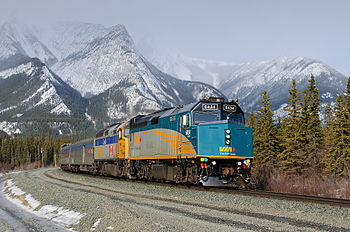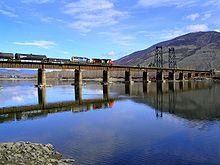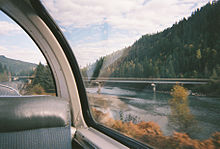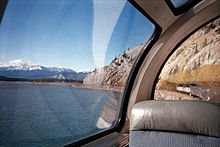
Canadian (train)
Background to the schools Wikipedia
SOS Children produced this website for schools as well as this video website about Africa. Click here to find out about child sponsorship.
| The Canadian | |
|---|---|
 The westbound Canadian near Jasper, Alberta |
|
| Overview | |
| Service type | Intercity rail |
| Status | Operating |
| Locale | Western Canada, Northern Ontario |
| Current operator(s) | Via Rail Canada |
| Former operator(s) | Canadian National, Canadian Pacific |
| Route | |
| Start | Toronto, Ontario |
| No. of intermediate stops | 65 (55 on request only) |
| End | Vancouver, British Columbia |
| Distance travelled | 4,466 km (2,775 mi) |
| Average journey time |
Westbound: 3 days 8 hours 42 minutes Eastbound: 3 days 10 hours |
| Service frequency | two trains per week in each direction until May 1, 2013; then, three trains per week in each direction until October 31, 2013. |
| On-board services | |
| Class(es) | Economy, Sleeper Touring |
| Disabled access | yes |
| Seating arrangements | Coach seating |
| Sleeping arrangements | Berths, Bedrooms for one, two or three |
| Catering facilities | Dining Car, Skyline Cafe (peak season only), take out, bar |
| Observation facilities | Skyline car, Park Car |
| Baggage facilities | Checked baggage available at selected stations |
| Technical | |
| Gauge | 4 ft 8 1⁄2 in (1,435 mm) |
| Track owner(s) | GO, CN, CP, BNSF |
| Timetable number(s) | 1,2 |
The Canadian (Le Canadien) is a Canadian transcontinental passenger train operated by Via Rail Canada with service between Union Station in Toronto, Ontario, and Pacific Central Station in Vancouver, British Columbia. Before 1955 the Canadian was a Canadian Pacific Railway train between Toronto and Chicago. In 1955 CPR renamed its transcontinental route between Montreal/Toronto and Vancouver the Canadian, with new streamlined trains. Via Rail took over in 1978, and in 1990 reduced the Canadian to Toronto - Vancouver service along a Canadian National line.
Canadian Pacific
In the years following World War II, passenger trains on the CPR consisted of a mixture of prewar heavyweight and pre- and post-war lightweight cars, even on their flagship transcontinental The Dominion and its eastern extension, The Atlantic Limited. While these cars were serviceable, American trains of the early 1950s, such as the California Zephyr, had already adopted streamlined all- stainless steel consists featuring domed observation cars. Following an evaluation in 1949 of the dome cars featured on the General Motors / Pullman Standard demonstrator Train of Tomorrow, CPR management, including then Vice President Norris Crump, resolved to upgrade their rolling stock. In 1953, CPR placed an order for 155 stainless steel cars with the Budd Company of Philadelphia that included 18 rear-end dome cars (Park series), 18 Skyline mid-train dome cars, 30 coaches, 18 dining cars and 71 sleeping cars (Manor and Chateau series). A subsequent order for 18 baggage-crew dormitory cars brought the final to total to 173 cars, sufficient for establishing an entirely new transcontinental service and partially re-equippiping The Dominion. The interior design of these new cars was contracted to the Philadelphia architectural firm Harbeson, Hough, Livingston & Larson (a company known for its industrial designs on other prominent passenger trains such as the Pioneer Zephyr), and the resulting furnishings and pastel-shaded colour schemes were widely acclaimed. After deciding to name the Park series dome cars after famous Canadian parks, leading Canadian artists, including members of the Group of Seven, were commissioned to paint suitable murals for these cars. When the decision was made to add budget sleeping cars, the Budd order was supplemented by 22 existing heavyweight sleepers that CPR refurbished in its own Angus Shops, each fitted out with Budd-style stainless steel cladding. To complement the new rolling stock, the CPR ordered General Motors Diesel FP9 locomotives to supplement an existing fleet of FP7s. Although these F-units remained the preferred power for the train, it was occasionally pulled by a variety of motive power, including Montreal Locomotive Works FPA-2s, and, as late as 1959, steam locomotives.
CPR christened their new flagship train The Canadian and service began on April 24, 1955. (The name had previously been used for a CPR train between Montreal/Toronto and Chicago.) Although CPR competitor Canadian National Railways began its own new transcontinental service, the Super Continental, on the same day, CPR was able to boast honestly that The Canadian was "The first and only all-stainless steel 'dome' stream-liner in Canada" — it was not until 1964 that the CNR acquired dome cars. CPR operated the train in two sections east of Sudbury, Ontario. The section operating between Montreal and Vancouver (also serving Ottawa) was known as train 1 westbound and train 2 eastbound, with a connecting section to or from Toronto splitting or joining at Sudbury (this section was known as train 11 westbound, and train 12 eastbound). Matching its streamlined appearance, The Canadian's 71 hour westbound schedule was 16 hours faster than that of The Dominion.
Although initially successful, passenger train ridership began to decline in Canada during the 1960s. Facing competition from airlines and increased automobile usage following construction of the Trans-Canada Highway, the CPR cancelled The Dominion in 1966, and petitioned the government to discontinue The Canadian in 1970. Although this petition was denied, CPR during the 1970s attempted to remove itself from the passenger service market. The Canadian was operated at reduced levels, with the government subsidizing 80 percent of its losses.
Via Rail

The Canadian in Calgary, 1982
|
The federal Crown corporation Via Rail Canada formally assumed responsibility for CPR's passenger services on October 29, 1978, although the Via identity was not assumed by the trains themselves until the following summer. Following the takeover by Via, the Canadian became the company's premier transcontinental train, and initially operated over its old CPR route. It was supplemented by the former CN Super Continental, which operated over the parallel, but more northerly, CN route. The Canadian continued to be operated in two sections east of Sudbury and provided daily service west to Vancouver and east to Toronto and Montreal.
In the aftermath of the deep budget cuts made to Via Rail on January 15, 1990, the Super Continental service was abolished and the Canadian was moved from the CPR route to the Super Continental's CN route. This maintained transcontinental service and allowed Via to operate its government-mandated service to small communities along the line. The new longer route bypassed Regina and Calgary in favour of Saskatoon and Edmonton. Service was reduced to three days per week, from previous daily service on both CP and CN routes. Today, Via Rail continues to operate the Canadian using the CN route with rebuilt ex-CPR Budd passenger equipment.
Route
- Vancouver-Kamloops
The Canadian's eastbound journey begins at Vancouver's Pacific Central Station. It uses the BNSF tracks (on which CN and the Canadian have trackage rights) through suburban communities including Burnaby, to New Westminster. Tracks and stations of the Skytrain light-rail system can be seen from the train as the system generally parallels the Canadian's route. Perhaps the most spectacular structure on the system is the Skytrain Bridge, a large bridge carrying light-rail trains across the river. The bridge can be seen from the train for a few miles as the train nears and crosses the New Westminster Bridge. Both the Skytrain and Pattullo (highway) bridges can be seen (to the right going east/south)during the crossing. After the train crosses the bridge, it enters CN tracks (CN goes to the left/east; BNSF and Amtrak to Seattle go to the right/west) and then passes through several railroad yards and maintenance areas before it reaches Gifford.
CN and CPR have agreements which allow directional travel through the Fraser and Thompson River canyons. All eastbound trains (CN, CPR, and the eastbound Canadian) use the CPR tracks. All westbound trains (CN, CPR, and the westbound Canadian) use the CN tracks. This allows the Canadian to travel on small portion of its original CPR route. At Gifford, the train diverts from the CN mainline and crosses the Fraser River to Mission, where it enters the CPR track. Mission, by the way, is the easternmost terminus of the West Coast Express, a commuter train service that operates on the Canadian's original route from the Waterfront Station (Canadian Pacific station) in downtown Vancouver over the CPR line.
From Mission, the Canadian travels on the CPR route through the Fraser and Thompson river canyons.The CPR stays on the west (north) side of the river until Cisco where it crosses over to the east (south) side of the river. At Basque (near Lytton), both the CPR and CN are on the same side of the river and have crossovers to access each other's tracks, and it is here that the eastbound Canadian transfers from the CPR back onto the CN line. Shortly thereafter the CN line crosses back over to the west/north side of the Thompson River for the rest of the way to Kamloops and crosses the North Thompson River before arriving at the Kamloops station, which is actually in North Kamloops, across the Thompson river from downtown Kamloops. The Canadian continues east on the CN on to Toronto, making stops at Edmonton, Saskatoon and Winnipeg. Both east and westbound Canadians travel through the Fraser and Thompson river canyons at night, so sightseeing from the train may be limited.
Westbound, the Canadian stays on the CN tracks all the way into Vancouver. Two of the highlights of the CN route include the ride through Painted Canyon in which the train clings about 200 feet (61 m) above the Thompson River and the crossing of CN's 800-foot (240 m) steel-arched bridge over the Fraser River and the CPR mainline at Cisco. After Cisco, the CN mainline stays of the east/south side of the Fraser River all the way to the New Westminster Bridge, following the same route as the eastbound train into Vancouver. The train ends its westbound journey by backing into the station.
- Kamloops–Jasper
Standing at the North Kamloops station, the train is actually facing north and will be travelling north, at least in a northerly direction, for about the next six hours. The train follows the North Thompson River (see map) for much of the way, crossing it several times. The scenery changes gradually from the dry, rolling plateau – though miles of irrigation soften the starkness – to the lusher, evergreen forests farther north. Narrow valleys bordered by mountains on both sides feature farmlands, pastures, forests, logging camps, and small communities. Clearwater and Blue River are two such communities where the Canadian has flag stops. Near Clearwater, the train crosses the Clearwater River. The Monashee Mountains lie to the east for much of the way to Valemount.
Some of the most dramatic segments along the route occur in this area as the train clings precariously to the mountainsides – particularly Groundhog Mountain and Mount Cheadle. One place in particular is known as Little Hells Gate (Port d'Enfer), a area featuring treacherous rapids on the river similar to those in Hells Gate farther south on the Fraser River. Passengers will note railway slide fences on one side of the train. These wire fences protect the tracks and train from falling debris. When a wire breaks or is compromised, it sends a signal to stop or proceed at a much slower speed. As it is, the train creeps along at a cautious pace – 26–30 miles per hour (42–48 km/h) – along this stretch. It is not difficult to see why. On the other side of the train are views to the North Thomspon River down below as well as toward the often-snow-covered mountains in the distance. One of the prettiest sights in this area is of Pyramid Falls, which cascades 300 feet (91 m) down the side of Mount Cheadle. The train slows down enough for passengers to get close-up looks and maybe get a nice picture or two. The Cariboo Mountains and Slide Mountain are to the west. Malton Range is to the east. The train crosses the Canoe River over a 240-foot (73 m) bridge shortly before arriving Valemount. It was also south of Valemount and north of the Canoe River where the Canoe River crash occurred on November 21, 1950. Memorials can be seen from the train. The icefields of the Albreda Glacier should be visible for several miles.
Valemount, "Valley in the Mountains," sits in a valley surrounded by mountains and is a flag stop for the Canadian. The Selwyn Range is to the east, and the Premier Range is to the west. The Premier Range is so named because some of the peaks are named after prime ministers of Canada, the United Kingdom, and premiers of British Columbia. Mount Sir Wilfrid Laurier (3,516 metres / 11,535 feet) and Mount Sir John Abbott (3,398 metres / 11,148 feet) are two such mountains.
North of Valemount is another area where eastbound and westbound trains (both CN and the Canadian) follow different routes. Out of Valemount, the eastbound train uses the Albreda Subdivision, which continues climbing along and often clings to the side of mountains from which there are views of the mountains and valleys below and beyond. Eventually and finally, the train rounds a sweeping curve (near Jackman, at Milepost 65.5) and heads in a more easterly direction though still high up on the mountainside. Mount Robson comes into view. At 12,972 feet (3,954 m), it is the tallest mountain in the Canadian Rockies. The mountain often makes its own weather and can be seen in its entirety fewer than 20 days a years. Even with the clouds, it can still be a scenic highlight for train passengers. The train has also been passing through Mount Robson Provincial Park. The train passes through a 1,670-foot (510 m) tunnel, where in 1905 an avalanche buried railroad workers, and continues its descent to Redpass, where it joins with the Robson Subdivision. It is lower in elevation and has more favourable grades for westbound trains than the Albreda Subdivision. The Robson Subdivision is used by westbound freights, the westbound Canadian and the westbound Jasper – Prince Rupert train. The eastbound Jasper – Prince Rupert train and eastbound freights off the Tête Jaune Subdivision from Prince George and Prince Rupert use the Albreda Subdivision. Incidentally, Tête Jaune ("Yellowhead" in French) and Yellowhead (Highway, Pass, Mountain, etc) get their names from Pierre Bostonais, an Iroquois-Métis man who had blond hair.
Redpass Junction is near the western shore of Moose Lake, which is known for its cold, deep waters. It is another scenic highlight, as the train follows along the north shore of the lake for several miles, and are a couple of splashing waterfalls cascading down from the mountains into the lake. The Selwyn Range borders the south shore of the lake. The train has essentially gone around the range. The Yellowhead Highway (Highway #16) parallels the CN tracks to the north.





